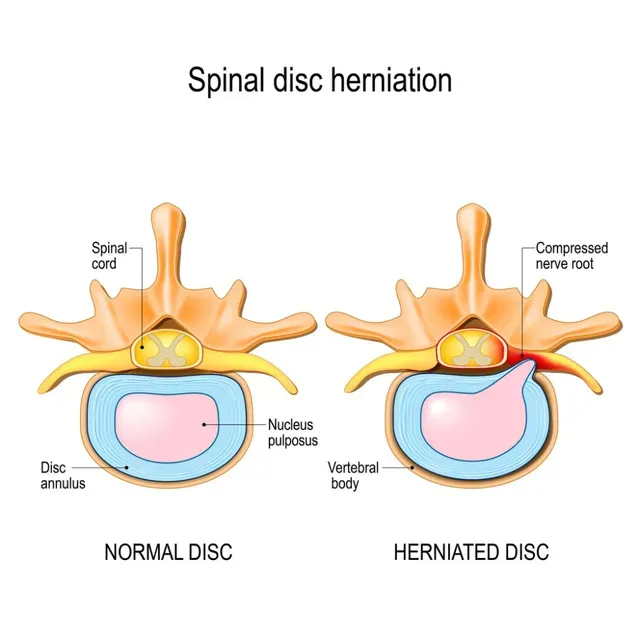Back pain is the leading cause of disability worldwide. Back pain affects between 70-85% of adults at some point in their life, while 40% of adults have recurring back pain. Low back pain can arise slowly over time or from an initial injury, such as a herniated, bulged, or slipped intervertebral disc. An intervertebral disc is a cushion of cartilage between each two vertebrae in the spinal column, and are crucial for proper functioning of the spine. They provide shock-absorption and allow the spine to freely move while still being stable. An intervertebral disc consists of an innermost gel-like section, called the nucleus pulposus, and an outer, tough, fiber section called the annulus fibrosis (4, 6). A bulged or slipped disc is caused by the nucleus pulposus pushing against the annulus fibrosis. A herniated disc is caused when the nucleus pulposus herniates outside of the annulus fibrosis, usually due to a trauma. Both a herniated disc or a bulged disc can protrude against a nerve and cause back pain, as well as pain traveling down an arm or leg.
A herniated disc may cause back, leg, and/or arm pain, but there are often positive outcomes. While many individuals relate their pain to a previously herniated disc, over 85% of patients with an acute herniated disc report no symptoms after 8-12 weeks! (2) There are MRI research studies that show discs resorbing spontaneously on their own. Several studies even show that the more severe a disc injury, the more likely it is to resorb. According to Benson et. al., in less than two years, 83% of patients had complete recovery after a disc herniation. MRI scans found an average of a 64% decrease in disc size (1). Other studies show resolution of symptoms within one year (5). Regardless of the timeline, studies consistently show a reduction in symptoms after a disc herniation.
Conservative management, including physical therapy, should be the first mode of treatment after an initial injury. Kerr et. al. states that there is no difference between surgery and conservative management at 8-year follow up (3). Physical therapy can help accelerate the healing process, reduce pain, improve patient’s body mechanics, target muscle imbalances, and more. While surgery definitely has a place in treatment for herniated discs and low back pain, it is not always required.
There are many contributing factors to low back pain. A previously herniated disc can definitely play a role in low back pain, but many patients also have movement dysfunctions, muscle imbalances, abnormal mobility of the vertebrae in the low back, and others. It is important to visit a physical therapist when symptoms persist for longer than a week in order to determine the underlying cause of the low back pain so it can be promptly solved.
Author: Dr. Osama Imam PT, DPT, Cert. DN
References:
1. Benson, R. T., Tavares, S. P., Robertson, S. C., Sharp, R., & Marshall, R. W. (2010). Conservatively treated massive prolapsed discs: a 7-year follow-up. Annals of the Royal College of Surgeons of England, 92(2), 147–153. https://doi.org/10.1308/003588410X12518836438840
2. Dydyk AM, Ngnitewe Massa R, Mesfin FB. Disc Herniation. [Updated 2020 Aug 12]. In: StatPearls [Internet]. Treasure Island (FL): StatPearls Publishing; 2020 Jan-. https://www.ncbi.nlm.nih.gov/books/NBK441822/
3. Kerr, Dana, Wenyan Zhao, and Jon D. Lurie. “What are long-term predictors of outcomes for lumbar disc herniation? A randomized and observational study.” Clinical Orthopaedics and Related Research® 473.6 (2015): 1920-1930. Level of evidence: 2B
4. Marchand, F. and A.M. Ahmed, Investigation of the laminate structure of lumbar disc anulus fibrosus. Spine (Phila Pa 1976), 1990. 15(5): p. 402-10.
5. Orief, T., Orz, Y., Attia, W., & Almusrea, K. (2011, April). Spontaneous Resorption of Sequestrated Intervertebral Disc Herniation. World Neurosurgery, 77(1). doi:https://doi.org/10.1016/j.wneu.2011.04.021
6. Waxenbaum JA, Reddy V, Futterman B. Anatomy, Back, Intervertebral Discs. [Updated 2020 Aug 10]. In: StatPearls [Internet]. Treasure Island (FL): StatPearls Publishing; 2020 Jan-. https://www.ncbi.nlm.nih.gov/books/NBK470583/

